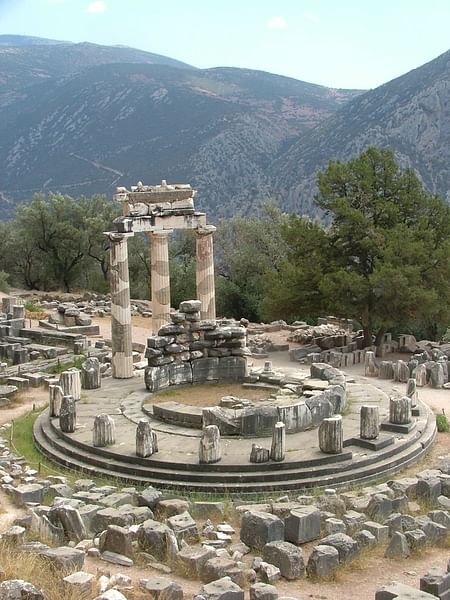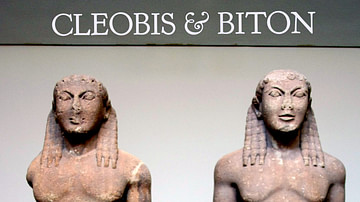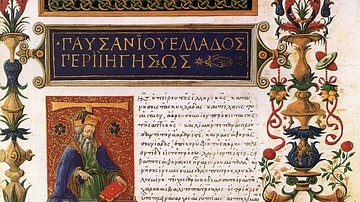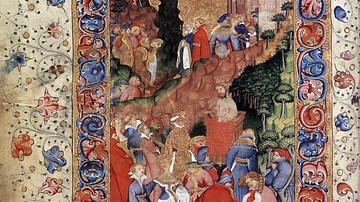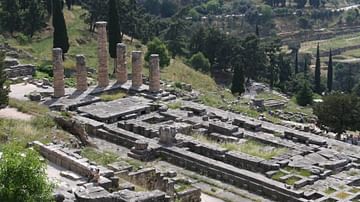
Delphi was an important ancient Greek religious sanctuary sacred to the god Apollo. Located on Mt. Parnassus near the Gulf of Corinth, it was home to the famous oracle of Apollo which gave cryptic predictions and guidance to both city-states and individuals. In addition, Delphi was also home to the panhellenic Pythian Games. Delphi is a UNESCO World Heritage Site.
Mythology & Origins
The site was first settled in Mycenaean times in the late Bronze Age (1500-1100 BCE) but took on its religious significance from around 800 BCE. The original name of the sanctuary was Pytho after the snake which Apollo was believed to have killed there. Votive offerings at the site from this period include small clay statues (the earliest), bronze figurines, and richly decorated bronze tripods.
Delphi was also considered the centre of the world, for in Greek mythology Zeus released two eagles, one to the east and another to the west, and Delphi was the point at which they met after encircling the world. This fact was represented by the omphalos (or navel), a dome-shaped stone which stood outside Apollo's temple and which also marked the spot where Apollo killed the Python.
Apollo's Oracle
The oracle of Apollo at Delphi was famed throughout the Greek world and even beyond. The oracle - the Pythia or priestess - would answer questions put to her by visitors wishing to be guided in their future actions. The whole process was a lengthy one, usually taking up a whole day and only carried out on specific days of the year. First the priestess would perform various actions of purification such as washing in the nearby Castalian Spring, burning laurel leaves, and drinking holy water. Next an animal - usually a goat - was sacrificed. The party seeking advice would then offer a pelanos - a sort of pie - before being allowed into the inner temple where the priestess resided and gave her pronouncements, possibly in a drug or natural gas-induced state of ecstasy.
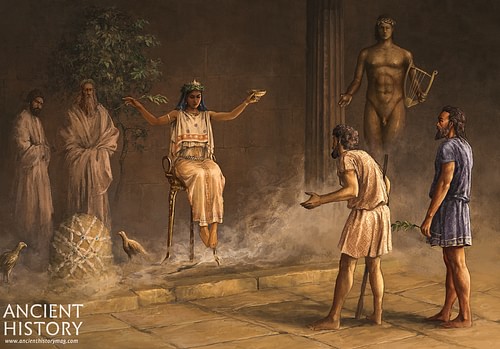
Perhaps the most famous consultant of the Delphic oracle was Croesus, the fabulously rich King of Lydia who, faced with a war against the Persians, asked the oracle's advice. The oracle stated that if Croesus went to war then a great empire would surely fall. Reassured by this, the Lydian king took on the mighty Cyrus. However, the Lydians were routed at Sardis and it was the Lydian empire which fell, a lesson that the oracle could easily be misinterpreted by the unwise or over-confident.
Panhellenic Games
Delphi, as with the other major religious sites of Olympia, Nemea, and Isthmia, held games to honour various gods of the Greek religion. The Pythian Games of Delphi began sometime between 591 and 585 BCE and were initially held every eight years, with the only event being a musical competition where solo singers accompanied themselves on a kithara to sing a hymn to Apollo. Later, more musical contests and athletic events were added to the programme, and the games were held every four years with only the Olympic Games being more important. The principal prize for victors in the Games was a crown of laurel or bay leaves.
The site and games were managed by the independent Delphic amphictiony - a council with representatives from various nearby city-states - which levied taxes, collected offerings, invested in construction programmes, and even organised military campaigns in the Four Sacred Wars, fought to redress sacrilegious acts against Apollo perpetrated by the states of Crisa, Phocis, and Amphissa.
Architecture
The first temple in the area was built in the 7th century BCE and was itself a replacement for less substantial buildings of worship which had stood before it. The focal point of the sanctuary, the Doric temple of Apollo, was unfortunately destroyed by fire in 548 BCE. A second temple, again Doric in style, was completed in c. 510 BCE with the help of the exiled Athenian family, the Alcmeonids. Measuring some 60 by 24 metres, the facade had six columns whilst the sides had 15. This temple was destroyed by earthquake in 373 BCE and was replaced by a similarly proportioned temple in 330 BCE. This was constructed with poros stone coated in stucco. Marble sculpture was also added as decoration along with Persian shields taken at the Battle of Marathon. This is the temple which survives, albeit only partially, today.
Other notable constructions at the site were the theatre (with capacity for 5,000 spectators), temples to Athena (4th century BCE), a tholos with 13 Doric columns (c. 580 BCE), stoas, stadium (with capacity for 7,000 spectators), and around 20 treasuries, which were constructed to house the votive offerings and dedications from city-states all over Greece. Notable amongst these mini-temples are the Athenian Treasury and the Siphnian Treasury.
Similarly, monuments were also erected to commemorate military victories and other important events. For example, the Spartan general Lysander erected a monument to celebrate his victory over Athens at Aegospotami. Other notable monuments were the great bronze Bull of Corcyra (580 BCE), the ten statues of the kings of Argos (c. 369 BCE), a gold four-horse chariot offered by Rhodes, and a huge bronze statue of the Trojan Horse offered by the Argives (c.413 BCE). Lining the sacred way, which wound from the sanctuary gate up to the temple of Apollo, the visitor must have been greatly impressed by the artistic and literal wealth on display. Alas, in most cases, only the monumental pedestals survive of these great statues, silent witnesses to a lost grandeur.

Demise
In 480 BCE the Persians attacked the sanctuary and in 279 BCE the sanctuary was again attacked, this time by the Gauls. It was during the 3rd century BCE that the site came under the control of the Aitolian League. In 191 BCE Delphi passed into Roman hands; however, the sanctuary and the games continued to be culturally important in Roman times, in particular under Hadrian. The decree by Theodosius in 393 CE to close all pagan sanctuaries resulted in Delphi's gradual decline. A Christian community dwelt at the site for several centuries until its final abandonment in the 7th century CE.
The site was 're-discovered' with the first modern excavations being carried out in 1880 CE by a team of French archaeologists. Notable finds were splendid metope sculptures from the treasury of the Athenians (c. 490 BCE) and the Siphnians (c. 525 BCE) depicting scenes from Greek mythology. In addition, a bronze charioteer in the severe style (480-460 BCE), the marble Sphinx of the Naxians (c. 560 BCE), the twin marble archaic statues - the kouroi of Argos (c. 580 BCE) and the richly decorated omphalos stone (c. 330 BCE) - all survive as testimony to the cultural and artistic wealth that Delphi had once enjoyed.
